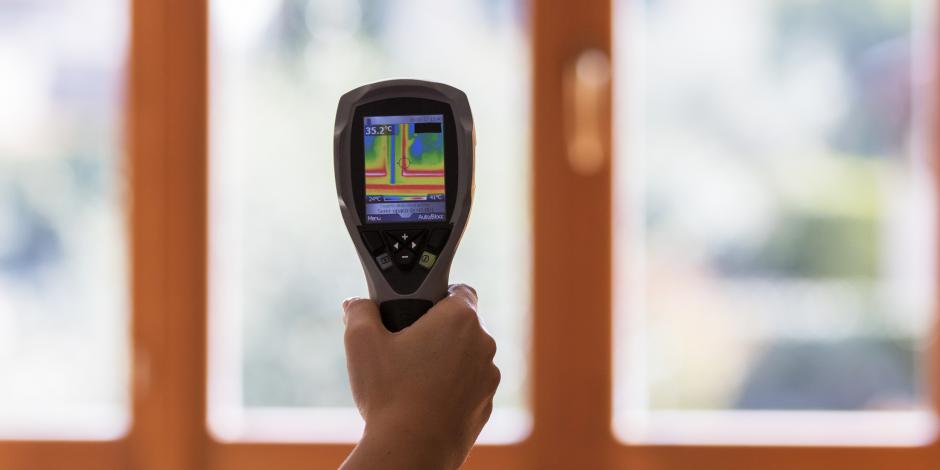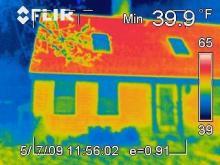
 One of the key components of an effective home energy audit is infrared thermography: a special camera takes thermal images that show temperature differences which can reveal hidden airflows. Infrared thermography (or infrared imaging, infrared diagnostics, a rose by any other name...) consists of a thorough visual inspection of a home, including the basement, attic, and all the nooks and crannies, with an infrared camera or another infrared assessment device. This technology assists in pinpointing the drafts and the leaky spots within a home — registering, as it will, the relative temperature of various spots within the home, and, depending on the device used, providing you, the homeowner, with a visual representation of the observed anomolies in your home's thermal envelope. So if, after the energy audit, you forget where exactly it was you were supposed to caulk, you've got a big stack of pictures to show you exactly what spots need air sealing or insulation work.
One of the key components of an effective home energy audit is infrared thermography: a special camera takes thermal images that show temperature differences which can reveal hidden airflows. Infrared thermography (or infrared imaging, infrared diagnostics, a rose by any other name...) consists of a thorough visual inspection of a home, including the basement, attic, and all the nooks and crannies, with an infrared camera or another infrared assessment device. This technology assists in pinpointing the drafts and the leaky spots within a home — registering, as it will, the relative temperature of various spots within the home, and, depending on the device used, providing you, the homeowner, with a visual representation of the observed anomolies in your home's thermal envelope. So if, after the energy audit, you forget where exactly it was you were supposed to caulk, you've got a big stack of pictures to show you exactly what spots need air sealing or insulation work.If a picture, as they say, is worth a thousand words, an infrared picture could very well be worth a thousand bucks, because it can reveal problem spots where your house is wasting energy (and money), and allows for clear strategies for fixing them. Some of the imperfections in your home's thermal envelope will be obvious: around windows and doors, for example. But chances are, there will be some big surprises, too; and that's part of what makes infrared imaging so valuable - you might discover that the constant draft in your living room could be taken care of with a simple bead of caulk along the baseboard, or that your perennial ice dam could be forever prevented by insulating a hot water pipe in the attic.
One last thing to bear in mind when scheduling an Infrared Audit is that for best results, there needs to be a temperature differential (delta T) between indoors and outdoors. Recommendations as to precise numbers differ, but you should talk to your auditor about an ideal differential for your region, climate and house.
What is Home Performance?
When you buy a car, you expect good gas mileage with low upkeep, safe handling, and comfort inside. In other words, respectable performance. Why would you have any other expectations for a house? The ability of your home to deliver comfort, health, and affordability is what a Home Performance Assessment is all about. Is the home functioning at its optimum? Or are there deficiencies and inefficiencies? An assessment can often determine which cost effective items can improve the performance of your home most!
Check out the Home Performance Assessment page and its Learn page for the issues and how your home can be improved!
Are you new to Home Ownership?
Make sure you look at the suggestions on my Renovations page; more useful information on my Real Estate Pages; and an excellent read on the Building Science Corporation's website: The Building Science Guide to Home Ownership! See my LINKS page for more.
Of course, feel free to call (718.941.3725) or email me with questions and concerns!
Are you a builder or developer looking to meet new local energy codes or Energy Star?
As an independent third party, I can provide initial and test-out Blower Door and CAZ testing along with Infrared imagery to help make your project a success.
Contact me for more information.
